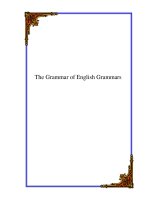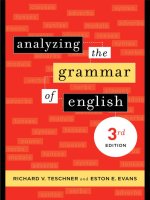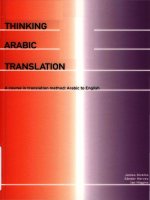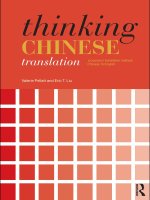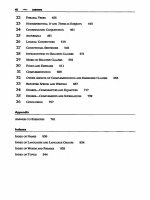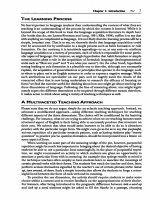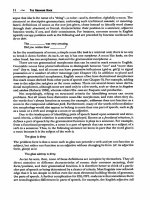The grammar translation method quiz
Bạn đang xem bản rút gọn của tài liệu. Xem và tải ngay bản đầy đủ của tài liệu tại đây (65.4 KB, 4 trang )
METHODOLOGY 1 – October 17,2006
Check your understanding about The Grammar-Translation Method
Student’s name:
……………………………………………………………………………………….
The Grammar-Translation Method focuses on: (check the correct answers)
1. reading and writing skills
2. listening and speaking skills
3. vocabulary
4. pronunciation
5. accuracy
6. grammatical analysis
7. content of texts
8. application of grammatical knowledge into translating sentences and
texts
9. memorization
10.
active use of the target language
11.
literature and fine arts
12.
teacher – student interaction
13.
student – student interaction
METHODOLOGY 1 – October 17,2006
Check your understanding about The Grammar-Translation Method
Student’s name:
……………………………………………………………………………………….
The Grammar-Translation Method focuses on: (check the correct answers)
1. reading and writing skills
2. listening and speaking skills
3. vocabulary
4. pronunciation
5. accuracy
6. grammatical analysis
7. content of texts
8. application of grammatical knowledge into translating sentences and
texts
9. memorization
10.
active use of the target language
11.
literature and fine arts
12.
teacher – student interaction
13.
student – student interaction
METHODOLOGY
February 28, 2007
THE GRAMMAR TRANSLATION METHOD
Exercise 1: Which of the following statements describes the Grammar
Translation Method’ s principles. Which don’t? Circle your
choice.
1. An important goal for students is to be able to translate each
language into the other.
2.
Another goal for students is to be able to communicate.
3.
The content of learning is typically embedded in literature and fine art
of the target language country.
4.
The teacher is the authority in the classroom.
5. The teacher decides whether students’ answer is correct or not and
gets them self-correct.
6.
There are two kinds of reading comprehension.
7.
Learning involves a lot of memorization of grammar rules, and native
language equivalents for foreign language words.
8.
There is little student initiation and little student – student interaction.
9.
There is much attention given to speaking and listening.
10.
language.
The language that is used in class is mostly the students’ native
METHODOLOGY
February 28, 2007
THE GRAMMAR TRANSLATION METHOD
Exercise 1: Which of the following statements describes the Grammar
Translation Method’ s principles. Which don’t? Circle your
choice.
1.
An important goal for students is to be able to translate each
language into the other.
2.
Another goal for students is to be able to communicate.
3. The content of learning is typically embedded in literature and fine art
of the target language country.
4.
The teacher is the authority in the classroom.
5.
The teacher decides whether students’ answer is correct or not and
gets them self-correct.
6.
There are two kinds of reading comprehension.
7. Learning involves a lot of memorization of grammar rules, and native
language equivalents for foreign language words.
8.
There is little student initiation an little student – student interaction.
9.
There is much attention given to speaking and listening.
10.
The language that is used in class is mostly the students’ native
language.
Exercise 2: Which of the following techniques follows the Grammar
Translation Method’s principles? Which don’t? Circle your
choice.
1. The whole class read the given passage out loud after the teacher. The
teacher corrects their pronunciation carefully.
2. First the students are asked to work on a short passage. The teacher
then gives students a set of isolated adjectives and asks them to find
their synonyms from the passage.
3. The teacher explains carefully how to form the third singular person of
the simple present tense. Then he provide students with a list of
infinitive verbs and asks them to transform these verbs into third
singular person.
4. The teacher gets students to write answers to some reading
comprehension in their notebooks. Then he asks them to compare the
answers with one another.
5. The teacher asks students to write a composition about the system of
transportation in their hometown. They can use a bilingual dictionary
for words they don’t know.
6. The students are given a reading passage and required to underline its
main ideas.
7. After having students learn by heart a set of vocabulary that describe
a house, the teachers asks them to make up sentences in which they
use the new words.
Exercise 2: Which of the following techniques follows the Grammar
Translation Method’s principles? Which don’t? Circle your
choice.
1. The whole class read the given passage out loud after the teacher. The
teacher corrects their pronunciation carefully.
2. First the students are asked to work on a short passage. The teacher
then gives students a set of isolated adjectives and asks them to find
their synonyms from the passage.
3. The teacher explains carefully how to form the third singular person of
the simple present tense. Then he provide students with a list of
infinitive verbs and asks them to transform these verbs into third
singular person.
4. The teacher gets students to write answers to some reading
comprehension in their notebooks. Then he asks them to compare the
answers with one another.
5. The teacher asks students to write a composition about the system of
transportation in their hometown. They can use a bilingual dictionary
for words they don’t know.
6. The students are given a reading passage and required to underline its
main ideas.
7. After having students learn by heart a set of vocabulary that describe
a house, the teachers asks them to make up sentences in which they
use the new words.

